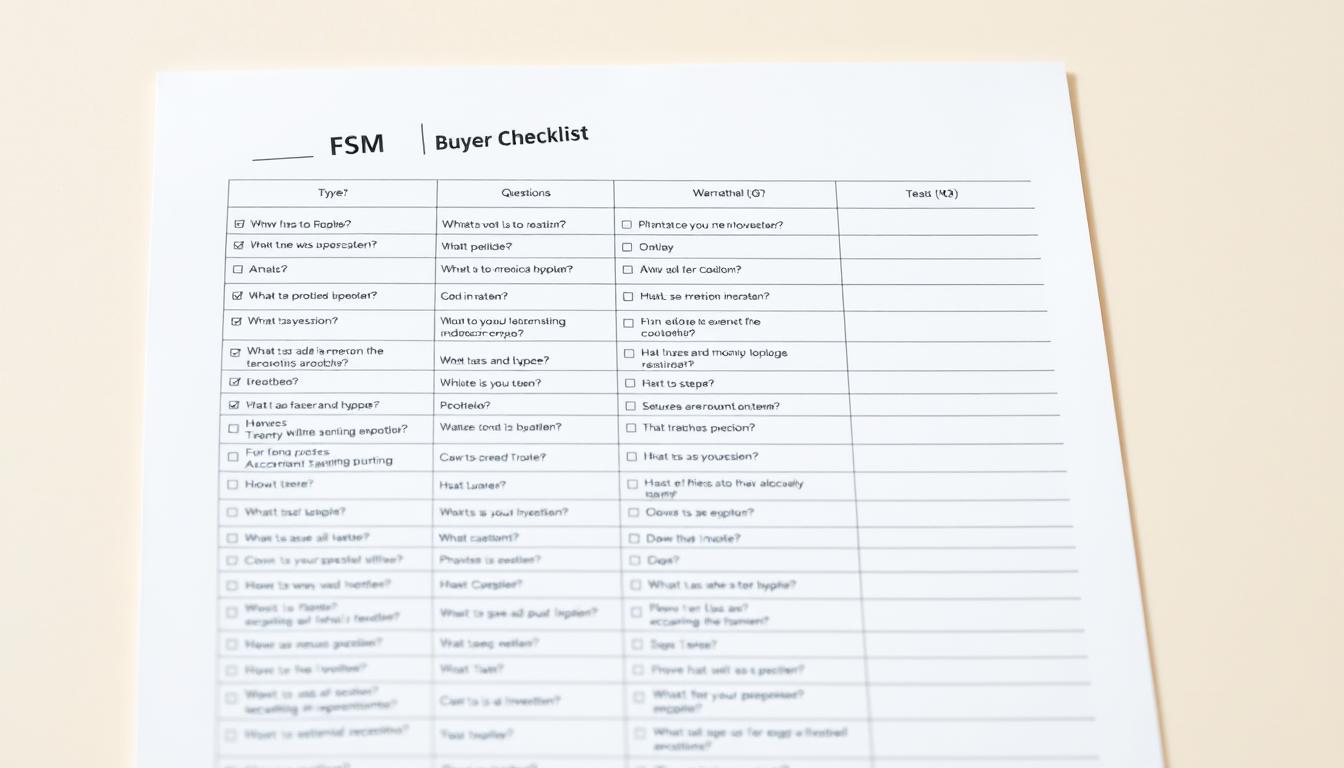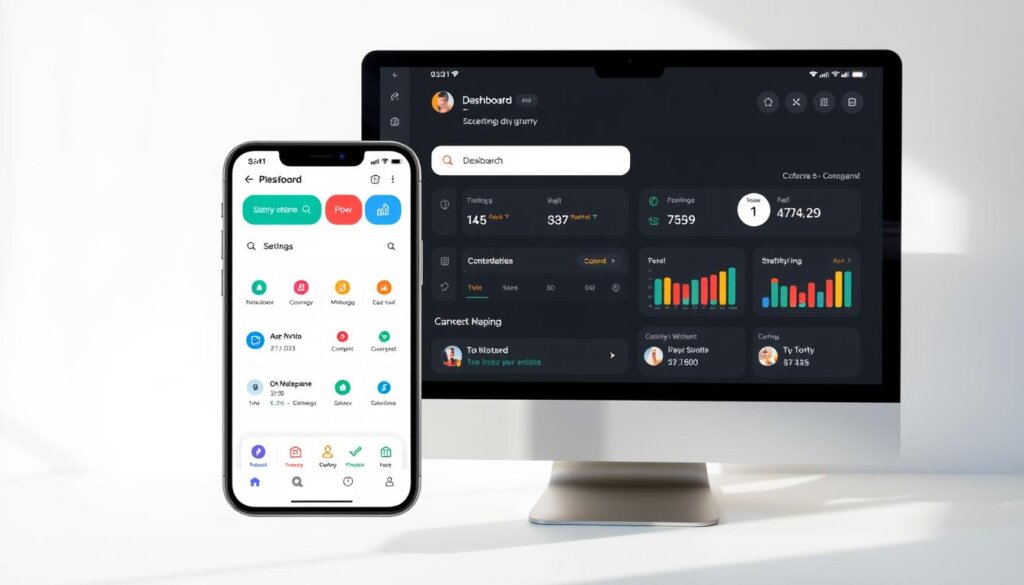I remember the morning I sat at my kitchen table with three vendor decks open and a coffee gone cold. I needed a clear way to compare platforms for my home and business service lines, so I sketched a simple set of questions that saved me weeks of back-and-forth.
That sketch evolved into this practical guide. It helps me quickly shortlist a field service management platform and avoid surprises later in the procurement cycle.
Verdantix’s December 27, 2024 report looked at 11 leading fsm solutions and flagged trends I care about: technician productivity, enterprise-stack integration, and AI readiness. I use those signals to shape my evaluation criteria and needs.
The 20 must-ask questions below streamline how I compare each fsm solution so I spend time on the right vendors and skip poor fits. They apply whether I run an asset-centric operation, a residential/home services team, or a mixed portfolio with mobile technicians.

Key Takeaways
- Use targeted questions to shortlist vendors fast and reduce demo time.
- Prioritize productivity, integration, and AI signals from the latest report.
- Apply the checklist to home, business, and mixed service models.
- Focus on mobile app usability, SLAs, payments, and management controls.
- The right questions save time during proofs of concept and contracting.
Why I Use A Buyer’s Guide Approach For Field Service Management Decisions
I built a short, repeatable way to evaluate platforms so I avoid being dazzled by flashy demos. This keeps my team focused on what matters for our business and our field work.
My goals are simple: a safer investment, smoother operations, and faster time-to-value. I want vendors to show proof of technician productivity, first-time fix rates, and reductions in swivel-chair work.
My goals: safer investment, smoother operations, faster time-to-value
Safer investment means clear SLAs, transparent pricing, realistic implementation plans, and references from my industry. I insist on seeing real workflows with my data and resources to validate fit against requirements.
How this checklist supports commercial evaluation and vendor shortlists
The checklist translates business needs into a repeatable process so stakeholders in operations, IT, and finance stay aligned. It focuses discovery on integrations, data mapping, and training resources that drive day-one value.
Using the same criteria, I build a fair vendor shortlist and a strong comparison for stakeholders. This approach scales from single field teams to multi-region and home service portfolios, so my decisions stay practical and defendable.
The 2025 Landscape: Field Service Management Market Signals I’m Watching
In 2025, deal activity and AI progress shape the practical criteria I use. The latest Verdantix report (date: December 27, 2024) pulls together 11 provider questionnaires and a survey of 304 executives. Those inputs show what actually drives adoption in the field: technician productivity, AI-enabled optimization, and clean enterprise integration.
Verdantix insights: technician productivity, AI optimization, and enterprise stack integration
Technician productivity tops my list because it links directly to cost and customer outcomes. I expect vendors to prove gains with real metrics, not marketing claims.
M&A momentum: capital flowing to solutions with recurring revenue and automation
Recent deals—Joblogic’s funding, ServicePower’s Inveniam purchase, and JDM Technology Group’s Successware acquisition—signal where capital is focused: automation, defensible margins, and home service coverage.
What “future-ready” means for my industry, customers, and service operations
Future-ready means integration without new silos, AI that works on day one, and roadmaps aligned to my industry needs—especially energy and asset-heavy workflows. Those signals directly inform my criteria for shortlists and vendor questions.
Translating My Business Needs Into Clear FSM Requirements
I start by documenting every service my teams deliver and why each one matters. I list break/fix, preventive maintenance, and installs, then map each task to the SLAs and KPIs that prove success.
From services delivered to features required:
I map the end-to-end process from scheduling to debrief so I can test each fsm solution against real work without manual workarounds. That includes customer communications, entitlements, contract rules, and the reporting that ties to first-time fix and mean time to repair.
Industry fit and integration
I segment requirements by industry—property portfolios, utilities, and home services—so vendors tailor demos to my environment. I define integration prerequisites early: ERP/EAM/CRM connections, asset hierarchies, and inventory models.
I also specify feature depth: offline mobile, parts and returns, warranty handling, and multi-asset work orders. Usability matters most; clear mobile UX and minimal taps drive technician adoption and uplift technician productivity.
FSM Buyer’s Checklis
I begin every vendor review with integration and mobile tests that reveal real implementation risk.
Platform & Integration Readiness
I ask for data models, API docs, and prebuilt connectors up front. I want to know how the vendor handles systems versioning and upgrades. I use Salesforce, IFS, and Praxedo examples to test real-world fit.
Mobile Workforce, Field Service, and App Experience
I test the mobile app for offline use, photo/video capture, barcode scans, and time-on-task metrics. These checks show whether technicians will adopt the tool or fight it.

Customer Experience, Payments, and Service Management
I require ETA notifications, appointment windows, on-site payment options, and a customer portal. I also verify contract entitlements, SLAs, warranties, returns, and clear escalation paths.
Security, Compliance, and Data Governance
Role-based access, audit trails, SOC 2/ISO certifications, data residency, and encryption are non-negotiable for me.
Operations, Reporting, and Performance Management
I expect dispatcher dashboards, exportable reports for analytics, and out-of-the-box tools in a marketplace to speed configuration. For home and property work, I add multi-site templates, checklists, and technician-specific access.
Enterprise Integration, AI, and Data: The Technical Criteria I Won’t Compromise On
When I evaluate technical fit, I focus on the plumbing that keeps data flowing between systems and teams. Integration must be durable, not brittle, so my operations can scale without constant rewrites.
Connecting to ERP, EAM, and CRM systems without creating data silos
My non-negotiables are stable APIs, event webhooks, and clear ID strategies for assets and accounts. I expect bidirectional sync and prebuilt adapters where possible so I avoid brittle custom code.
AI and autonomous agents: practical use cases I expect on day one
I want day-one AI features that matter: recommended scheduling, parts suggestions, knowledge surfacing, and an autonomous agent in the mobile app to reduce routing and handle time.
Examples such as Salesforce’s autonomous agents and IFS’s EAM-aligned workflows show how AI should help technicians, not add complexity.
APIs, data access, and reporting that match my analytics and process needs
I require analytics-grade data models with documented schemas, change logs, and performance plans for large datasets. Access controls must follow least-privilege principles with field-level rules and full audit trails.
My validation approach is hands-on: sandbox tests, sample payloads, API rate checks, and performance runs. I test home service and property structures—sites, units, and assets—to ensure multi-tenant clarity and future scalability.
Pricing, Contracts, and Total Cost: How I Model ROI For FSM Software
I translate feature lists into payroll hours, parts usage, and revenue changes to forecast real ROI. That gives me a clear view of closing impact and the income the platform must drive.

Licenses, add-ons, and services
I break every cost into licenses, add-ons, integrations, implementation, and training. I build a multi-year TCO so I spot hidden fees and variable payment terms early.
Measuring benefits and validating value
I map benefits to metrics: first-time fix, technician utilization, reduced callbacks, and improved customer satisfaction. I then tie those gains to time-saved and incremental income for the business.
I set contract date controls—renewals, price caps, and SLA remedies—so growth does not inflate costs unexpectedly. I also use the latest report and public deals to benchmark offers and gain leverage during negotiation.
Finally, I document a 90–180 day validation process. That process confirms the solution delivers the promised benefits and clears payment milestones before final closing.
Implementation, Change Management, and Vendor Viability Checks
A smooth go-live often comes down to planning the small, practical steps that keep field teams productive on day one. I focus on a clear plan that ties project roles to milestones so operations move without surprise.
Go-live plan, training, and resources to reduce operational risk
I expect a go-live plan that lists resources: project team roles, data migration tasks, cutover dates, and hypercare windows. Training must cover dispatchers and technicians with in-app guides and quick-reference sheets for home and property teams.
Proof of stability: roadmaps, support SLAs, and financial strength
I use simple criteria to judge vendor viability: clear product roadmaps, published support SLAs, uptime history, and customer references. Recent 2025 deals underline why I care about operational excellence and clean contracts when choosing fsm solutions.
What strong documentation tells me about a vendor’s operational excellence
Well-structured systems docs, API references, change logs, and certification details show maturity. For closing I require UAT signoff, formal knowledge transfer, and a date-based transition plan so the final move is low risk.
I take time to verify viability because it prevents costly pivots and protects long-term business value from day one.
Conclusion
Deciding on the right solution comes down to measured pilots, clear metrics, and plain-language commitments.
I end with three waypoints I use to close confidently: clear requirements, verified integrations, and measurable outcomes from a scoped pilot.
I take time to validate field workflows, station logistics, technician work patterns, and maintenance checklists so the move from pilot to rollout is smooth.
Use this guide to run a comprehensive fsm evaluation that covers service management, mobile convenience, and secure data access across home and property work.
With recent market energy behind platforms that pair integration and AI, lock in pilot scope, set success criteria, and sequence closing tasks with ownership for a clean move to production.
See how FieldAx can transform your Field Operations.
Try it today! Book Demo
You are one click away from your customized FieldAx Demo!
FAQ
What key questions should I ask when evaluating a field service management platform?
I start by asking about integration capabilities with ERP, EAM, and CRM systems, mobile app functionality for technicians, scheduling and dispatch logic, offline data handling, security and compliance controls, and available APIs for reporting. I also probe vendor stability, roadmap, and support SLAs so I can model total cost and risk.
How do I map my business needs into clear solution requirements?
I list the services I deliver, map workflows and SLAs, define KPIs like first-time fix and mean time to repair, and identify the features that enable those outcomes—asset tracking, parts management, time capture, and automated scheduling. Then I prioritize must-haves versus nice-to-haves for vendor shortlists.
Which mobility features matter most for my field workforce?
I look for a responsive mobile app with offline capability, step-by-step job guidance, photo and video capture, digital forms, signature and payment capture, GPS tracking, and quick access to asset history. Those reduce errors and boost technician productivity.
What should I expect from integrations and data access?
I expect real-time or near-real-time integration to my ERP and CRM, robust RESTful APIs, secure webhooks, and a data model that supports reporting. Easy data export and access for BI tools is essential to avoid silos and enable performance management.
How do I evaluate AI and automation claims?
I ask for concrete use cases—predictive maintenance, intelligent scheduling, parts forecasting—and request demos with my data. I check whether automation improves measurable KPIs and whether the vendor supports explainability and human override.
What security and compliance checks should I require?
I require SOC 2 or ISO 27001 evidence, strong encryption for data at rest and in transit, role-based access control, audit logs, and clear data residency options. For regulated industries, I verify industry-specific compliance like HIPAA or NERC where relevant.
How do I model total cost of ownership and ROI?
I include license fees, implementation and integration costs, training, change management, ongoing support, and expected productivity gains. I quantify benefits such as reduced travel time, higher first-time fix rates, and faster billing to calculate payback and net present value.
What contract and pricing pitfalls should I watch for?
I avoid long lock-in without clear exit terms, watch for per-technician pricing traps, and request transparent pricing for add-ons like IoT connectors or advanced analytics. I negotiate service credits tied to SLAs and include phased milestones for payments tied to delivery.
How do I assess vendor viability and support capability?
I review financial health, customer references in my industry, case studies, churn rates, and support SLAs. I also check the vendor’s roadmap, partner ecosystem, and documentation quality to ensure they can deliver long-term value.
What implementation and change management practices reduce risk?
I require a clear go-live plan with pilot phases, role-based training, super-user programs, and a governance team. I ensure data migration and process mapping are tested thoroughly and that contingency plans exist for rollback or phased rollouts.
How should I evaluate reporting and performance management features?
I look for customizable dashboards, real-time KPIs, scheduled reports, drill-down capability, and native connectors to BI tools. The vendor should let me create metrics for technician productivity, SLA compliance, revenue per job, and asset uptime.
Can I expect the solution to handle industry-specific workflows like utilities or property services?
I confirm industry templates, configurable workflows, and support for asset hierarchies common to utilities, property management, or home services. I also check for integrations with industry tools and regulatory reporting features where needed.
What customer experience and payment features matter most?
I prioritize real-time appointment notifications, technician ETA tracking, digital invoicing, integrated payment capture, and customer self-service portals. These features speed billing, improve satisfaction, and increase on-time payments.
How do I validate mobile and field app usability before buying?
I run hands-on trials with my technicians using sample jobs, test offline scenarios, and measure task completion times. I gather direct feedback and observe whether the app reduces admin time and supports faster resolution in real conditions.
What role do APIs and extensibility play in long-term success?
APIs let me connect to existing systems, automate workflows, and build custom integrations. Extensibility ensures I can add modules—inventory, IoT, analytics—without replacing core systems. That protects my investment as needs evolve.
How important is real-time dispatching and scheduling optimization?
Real-time dispatching improves utilization and response times. I expect dynamic scheduling that considers skills, parts availability, travel time, and SLA priorities. Advanced optimization drives lower costs and higher first-time fix rates.
What maintenance and support options should I require?
I require 24/7 support for critical issues, defined escalation paths, regular patching, and clear maintenance windows. I also value professional services for complex integrations and ongoing training to keep my team effective.
How do I ensure data governance and ownership after implementation?
I insist on clear contractual terms for data ownership, export capabilities, and retention policies. I verify backup procedures, data residency options, and easy access to raw data for audits and analytics.
What metrics prove a successful deployment?
I measure technician utilization, first-time fix rate, mean time to repair, on-time arrival, customer satisfaction scores, and billing cycle time. Improvement in these areas shows the platform delivers operational and financial value.
How should I shortlist vendors effectively?
I create a weighted scorecard based on integration, mobile experience, automation, security, TCO, references, and roadmaps. I run product trials with real data and involve key stakeholders to ensure fit across operations, IT, and finance.
Author Bio
Co-Founder & CMO at Merfantz Technologies Pvt Ltd | Marketing Manager for FieldAx Field Service Software | Salesforce All-Star Ranger and Community Contributor | Salesforce Content Creation for Knowledge Sharing






